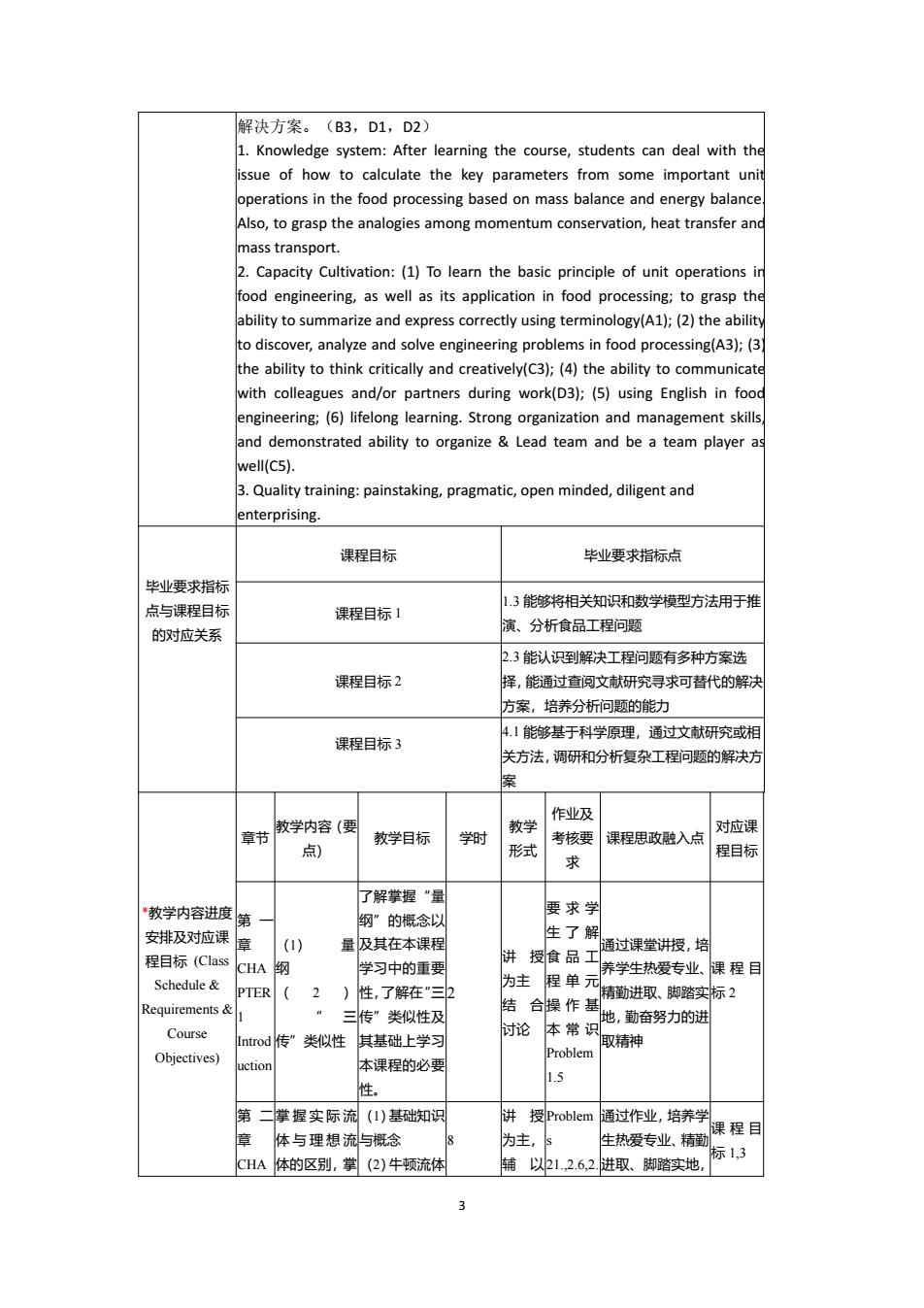正在加载图片...

解决方案。(B3.D1,D2) issue of how to calculate the key parameters from some important uni operations in the food processing based on mass balance and energy balance Also,to grasp the analogies among momentum conservation,heat transfer and mass transport. 2.Capacity Cultivation:(1)To learn the basic principle of unit operations food engineering,as well as its application in food processing;to grasp th ability to summarize and express correctly using terminology(A1);(2)the abilit to discover,analyze and solve engineering problems in food processing(A3);(3) the ability to think critically and creatively(C3):(4)the ability to communicat with colleagues and/or partners during work(D3):(5)using English in foo engineering:(6)lif long learning.Strong organization and management skill and demonstrated ability to organize Lead team and be a team player a well(C5). 3.Quality training:painstaking,pragmatic,open minded,diligent and enterprising. 课程目标 毕业要求指标点 华业要求指标 点与课程目标 13能够将相关知识和数学模型方法用于相 课程目标】 的对应关系 演、分析食品工程问题 2.3能认识到解决工程问题有多种方案选 课程目标2 择,能通过查阅文献研究寻求可替代的解 方案,培养分析问题的能力 4.1能够基于科学原理,通过文献研究或相 课程目标3 关方法,调研和份分析复杂工程问题的解决方 安 章书学内容(要 作NB 过成得 教学目标 学时 教 课程思玫融入点 点) 形式 考核要 求 程目材 教学内容进度第 了解掌握"星 要求学 安排及对应课 纲”的概念以 生了铝 (1) 量及其在本课程 诵课堂#授该 程目标C 讲授食品工 HA 学习中的重要 养学生热爱专业、裸程目 Schedule& 为主 程单 PTER 精勤进取、脚踏实标2 Requirements 类似性 Course Introd传”类似性 讨论 本常识地,勤奋努力的达 其基础上学习 取精神 Objectives) Problem 本果程的必要 15 性 第二掌握实际流(1)基础如识 授Problem通过作业,培养学 体与理想苏 课程目 与概念 为主 生热爱专业、精用 CHA体的区别,掌(2)牛顿流体 链邓1,262进取、期踏实地,标13 33 解决方案。(B3,D1,D2) 1. Knowledge system: After learning the course, students can deal with the issue of how to calculate the key parameters from some important unit operations in the food processing based on mass balance and energy balance. Also, to grasp the analogies among momentum conservation, heat transfer and mass transport. 2. Capacity Cultivation: (1) To learn the basic principle of unit operations in food engineering, as well as its application in food processing; to grasp the ability to summarize and express correctly using terminology(A1); (2) the ability to discover, analyze and solve engineering problems in food processing(A3); (3) the ability to think critically and creatively(C3); (4) the ability to communicate with colleagues and/or partners during work(D3); (5) using English in food engineering; (6) lifelong learning. Strong organization and management skills, and demonstrated ability to organize & Lead team and be a team player as well(C5). 3. Quality training: painstaking, pragmatic, open minded, diligent and enterprising. 毕业要求指标 点与课程目标 的对应关系 课程目标 毕业要求指标点 课程目标 1 1.3 能够将相关知识和数学模型方法用于推 演、分析食品工程问题 课程目标 2 2.3 能认识到解决工程问题有多种方案选 择,能通过查阅文献研究寻求可替代的解决 方案,培养分析问题的能力 课程目标 3 4.1 能够基于科学原理,通过文献研究或相 关方法,调研和分析复杂工程问题的解决方 案 *教学内容进度 安排及对应课 程目标 (Class Schedule & Requirements & Course Objectives) 章节 教学内容(要 点) 教学目标 学时 教学 形式 作业及 考核要 求 课程思政融入点 对应课 程目标 第 一 章 CHA PTER 1 Introd uction (1) 量 纲 ( 2 ) “ 三 传”类似性 了解掌握“量 纲”的概念以 及其在本课程 学习中的重要 性,了解在“三 传”类似性及 其基础上学习 本课程的必要 性。 2 讲 授 为主 结 合 讨论 要求学 生了解 食品工 程单元 操作基 本常识 Problem 1.5 通过课堂讲授,培 养学生热爱专业、 精勤进取、脚踏实 地,勤奋努力的进 取精神 课程目 标 2 第 二 章 CHA 掌握实际流 体与理想流 体的区别,掌 (1)基础知识 与概念 (2)牛顿流体 8 讲 授 为主, 辅 以 Problem s 21.,2.6,2. 通过作业,培养学 生热爱专业、精勤 进取、脚踏实地, 课程目 标 1,3